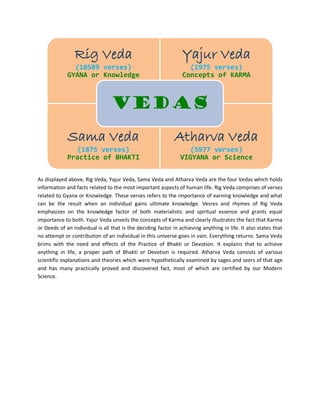

The origin and meaning of these designations are not very clear. There are two major recensions of this Veda known as the ‘Black’ and ‘White’ Yajur-Veda. Its purpose was practical, in that each mantra must accompany an action in sacrifice but, unlike the Sama-Veda, it was compiled to apply to all sacrificial rites, not merely the Soma offering. The Yajur-Veda (‘Veda of sacrificial formulas’) consists of archaic prose mantras and also in part of verses borrowed from the Rig-Veda. Rigveda is the oldest, largest and most important of the Vedas, containing ten thousand verses forming 1017 poems in 20 groups. According to others, the people in the times of the Rigveda had a settled home, definite mode of life, developed social customs, political organizations, and even arts and amusements. According to some, the concerns of Rigveda are those of simple, nomadic, pastoral Aryans. Rigveda contains a sense of intimate communion between Nature and the Rishis or visionaries. Some animals like horses, some rivers, and even some implements (like mortar and pestle) were deified. There are references to a divine creeper, the Soma, whose juice was an energizer. Other Rigvedic gods include Rudra, the two Ashvins,Savitar and Surya, Varuna, the Maruts and the Ribhus. About two-thirds of Rigveda is about the gods Agni (Fire) and Indra (Ruler of the gods). But it also dealt with other subjects, like the procedure of wedding, the folly of gambling. Rigveda means the Veda of Adoration and mostly contains verses adoring or adulating deities. There are strong linguistic and cultural similarities between the Rigveda and the early Iranian Avesta, deriving from the Proto-Indo-Iranian times, often associated with the Andronovo culture the earliest horse-drawn chariots were found at Andronovo sites in the Sintashta-Petrovka cultural area near the Ural mountains and date to ca.

Michael Witzel believes that the Rig Veda must have been composed more or less in the period 1450-1350 BCE. The books were composed by sages and poets from different priestly groups over a period of at least 500 years, which Avari dates as 1400 BCE to 900 BCE, if not earlier According to Max Müller, based on internal evidence (philological and linguistic), the Rigveda was composed roughly between 1700-1100 BCE (the early Vedic period) in the Punjab (Sapta Sindhu) region of the Indian subcontinent. The hymns are dedicated to Rigvedic deities.

It is a collection of 1,028 Vedic Sanskrit hymns and 10,600 verses in all, organized into ten books (Sanskrit: mandalas). The Rig-Veda Samhita is the oldest significant extant Indian text. The mystic dimensions and applications of these mantras as a way of obtaining the physical immortality was elaborated in Sri Aurobindo’s, The Secret of the Veda. Vedic mantras are recited at Hindu prayers, religious functions and other auspicious occasions. They came to us in written form between 4-6,000 years ago.Īccording to Hindu tradition, the Vedas are ‘not of human agency’, having been directly revealed, and thus are called sruti (‘what is heard’). Initially the Vedas were considered so sacred that they were only transmitted orally from one generation to the next spanning 100,000 years. They also had a vast influence on Buddhism, Jainism, and Sikhism. The Vedas are the primary texts of Hinduism. There are four Vedas, the Rig Veda, Sama Veda, Yajur Veda and Atharva Veda. They form the oldest layer of Sanskrit literature and the oldest sacred texts of Hinduism. The Vedas are a large body of texts containing hymns, poems, and ceremonial formulas originating in Ancient India.


 0 kommentar(er)
0 kommentar(er)
